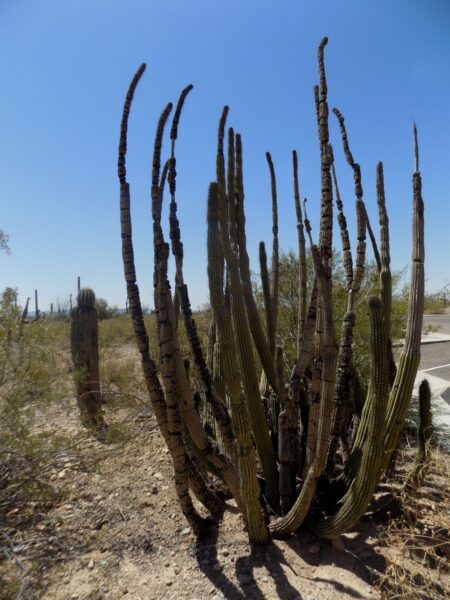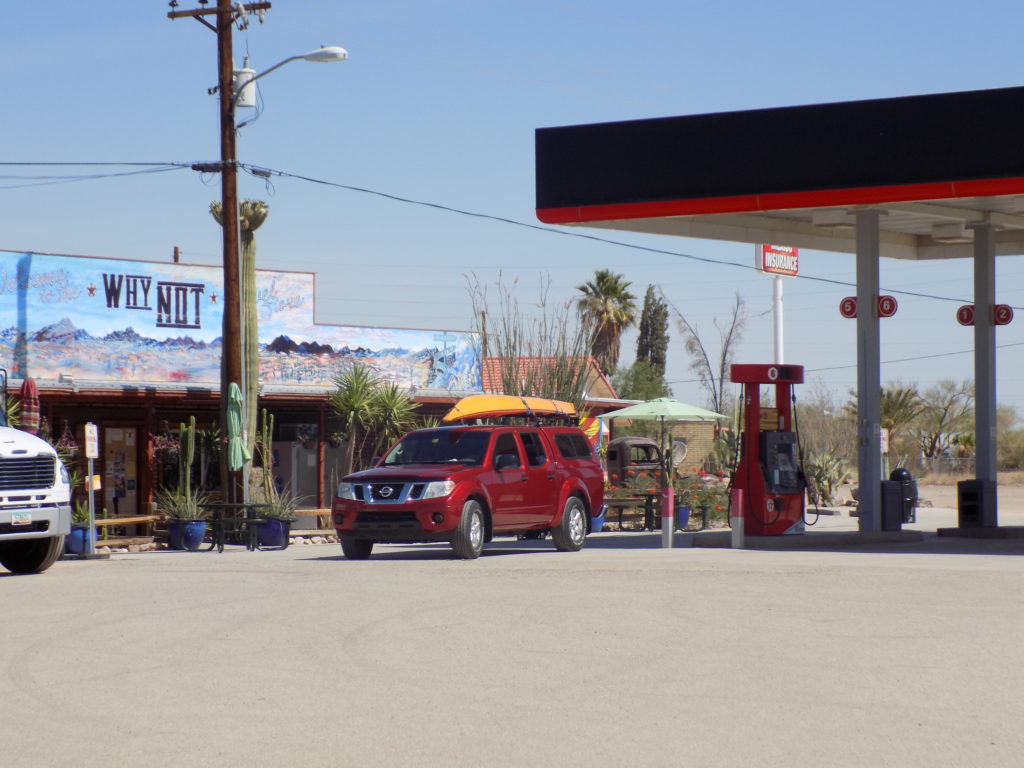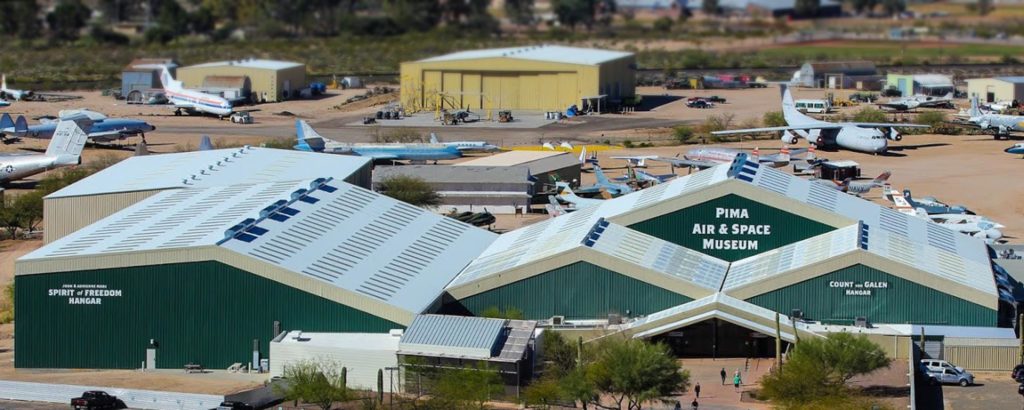Making baby cacti.
Now, letŌĆÖs look at the reproductive strategy of the two cacti.

(That’s a young saguaro on the left.)
Since itŌĆÖs not as long lived as the saguaro, typically reaching a maximum age of about 150 years, the organ pipe begins to flower between 32 and 38 years of age. Interestingly, the plant’s spines are brown or black in its youth but turn gray (not as gray as the “spines” emanating from my scalp but gray nonetheless) as it ages. The cactus flowers in the spring, producing funnel shaped purplish white, greenish white or greenish-brown flowers at the upper most tip of the branches and stems. The flowers are nocturnal and typically are closed by mid-morning.
Like the saguaro, the organ pipe’s root system is extensive and shallow – generally within the top four inches of soil – but its adaptation for surviving the summer heat is different. While it, too, protects itself from heat and water loss by storing large quantities of water in its pulpy flesh, it also uses a unique photosynthesis pathway, and shades itself with its sharp spines.
In addition to its flowers, the organ pipe produces (as noted by its Spanish name) a sweet red pulped fruit that ripens just before the summer rains. The fruit is round or oval and grows to be about the size of a tennis ball. As it ripens, it’s covered with spines. However, once itŌĆÖs fully ripe most of the spines fall off and the skin begins to crack.
Because most of the organ pipe cactuses grow in a protected area, the fruit isn’t readily available in the U S but it is still harvested in Mexico. In times past, the Pima and Papago tribes collected the ripe fruits and would eat them fresh to provide a source of calories and hydration in the summer months. They would also dry them for winter use and ferment them to make a sort of wine.
Regarding species perpetuation, the saguaro requires cross pollination to reproduce. Like the flowers on the organ pipe, the saguaroŌĆÖs flowers open at night and close the following afternoon eventually developing into fruits that humans don’t find as tasty as those from the organ pipe. Saguaros must be pollinated nocturnally when the flowers open. This pollination is carried out by nectar feeding bats, birds, and insects.
Once developed, each saguaro fruit contains about 2,000 tiny black seeds that may become the next generation. Interestingly, only certain species can help the plant survive. When the fruit and seeds are eaten by a coyote or cactus wren, the seeds pass through their digestive systems unharmed and are thus distributed throughout the desert when the animals defecate. However, when the seeds are eaten by a dove or quail, they will be completely consumed in the digestive system. Most experts believe that a mere handful of the 40,000,000 seeds a typical saguaro produces over its lifetime survive to adulthood.
Our friend the organ pipe also needs nighttime pollination of its flowers – generally by lesser long-nosed bats – to produce its fruit. However, as noted above, the skin of the fruit cracks as it ripens and, in what seems to be a more efficient reproductive method, the seeds fall out of the fruit. When the seeds reach the desert floor, they need only to find shelter from a rock or the occasional nurse plant to take root and grow into the many armed adult plants.
So sorry, we’re closed.
While the Ajo Mountain drive is only a 21-mile loop, the road is unpaved and the going can be slow particularly in a Hyundai Accent with low ground clearance. Even with minimal hiking, photography and reading explanatory signage, I spent about three hours on this drive. So, before I left the visitor’s center and knowing I’d be hungry long before I reached Tucson, I asked the ranger whether I might find a place for lunch. I get cranky when I’m hungry and even though I was alone, I don’t like being with me when I’m cranky.
He made what sounded like a wonderful suggestion – the Desert Rain Caf├® in Sells – the capital of the Tohono O’Odham Nation. He described it as serving healthy and traditional food prepared in the same ways that have fed the Native American people for centuries. Additionally, the food is predominantly organic, healthy, and produced mainly by tribal farmers and foragers. Healthy, organic food that helped support tribal farmers sounded like an ideal way to start my southwest adventure.
It seemed so appealing that when I passed back through the town of Why I answered this question with a resounding,
“Because I’m going to have a Native American lunch at the Desert Rain Caf├®.” Or so I thought. When I arrived, the caf├® was closed and I later learned it had closed permanently about a month earlier. For the remaining 63 miles to Tucson, through at least two construction sites, I was going to have to abide cranky Todd and I was none too happy about it. Fortunately, I stopped elsewhere in Sells and grabbed a Snickers and a bottle of water before setting off on the rather lonely drive to Tucson where I planned to visit
The Valley of the Moon.
The Valley of the Moon is the brainchild and creation of one George Phar Legler. He began work on it in 1923 with the help of his son Randall, his friend George Thibault, and anyone who would share in his dream, including many homeless men who worked with George in exchange for food and a place to stay but who, at least apocryphally, never accepted his offer to pay them.
The Valley of the Moon is a bit of a fantasy land with such areas as the Yellow Room, the Cave Rooms, and the Enchanted Garden. You see, George was a Spiritualist. Thus, his belief system included ghosts, spirits, and fairies. Deep in the heart of the valley you can find:
Unfortunately, when I was preparing for my trip and scouring the internet for interesting places to visit in Tucson, I failed to note that the attraction is open only on Saturdays. (The above picture of The Crossroads comes from the website where you can read more about it if you’re interested.)
Having failed to land on the moon, I aimed my car toward the Pima Air and Space Museum. My primary intent was to tour what’s known as the Boneyard. The Boneyard is actually the Aerospace Maintenance and Regeneration Group (AMARG) Facility on the Davis-Monthan Air Force Base. AMARG is home to more than 4,000 aircraft from the U S Air Force, Navy-Marine Corps, Army, Coast Guard, and several federal agencies including NASA in varying conditions. All the aircraft are being regenerated or recycled.
Although the Pima Air and Space Museum is a very large facility with substantial indoor and outdoor storage space, my home base proximity to the Smithsonian Air and Space Museums coupled with my experience of serving as a volunteer at both the Washington and Dulles facilities meant that, beyond the prospect of visiting the Boneyard, I was only minimally interested in the offerings of this museum. So, of course, when I arrived at 15:30, I learned the last Boneyard tour was scheduled for 14:00. It seemed somehow fitting and appropriate for the day. The image below is from the museum’s web page.
I chose to wander around some of the outdoor space for the hour and a half until the museum closed before taking the advice of one of the docents regarding a systematic method of taking some pictures of the Boneyard without taking the tour. ┬ĀI’ll explain my Boneyard obsession in a moment.
For me, two of the more intriguing planes at the museum were the propeller version of Air Force One that both Presidents Kennedy and Johnson used to fly into smaller airports and the NASA Super Guppy that was used to transport oversized objects. You can see them in my photo album. I was also able to find this YouTube video of the very awkward appearing Super Guppy taking off.
Now I’ll explain my Boneyard obsession. Those of you who followed me on my Mississippi River sojourn three years ago and on other trips I’ve made know that I like to visit cemeteries and movie locations when I travel and, in a way, the Boneyard fits both those descriptions. A relatively little known 1987 movie called Can’t Buy Me Love and starring a young Patrick Dempsey was filmed in and around Tucson in 1986. If you’re interested in the predictable storyline, you can look it up on imdb.com. However, one of the movie’s important scenes takes place in the Boneyard – although I suspect the wall the characters scale is in a different location.
From there, it was off to dinner in the revitalized Fourth Street district at the Thunder Canyon Brewery and, after my second night in Tucson, I’ll be off to the Grand Canyon tomorrow.


